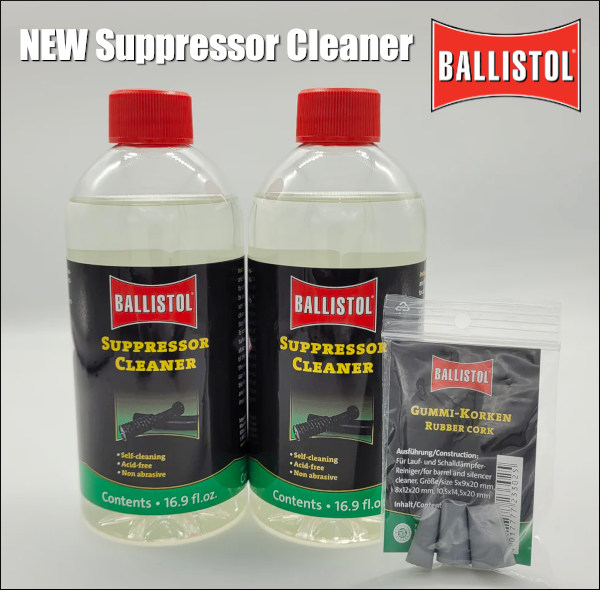In the USA, suppressors are becoming more popular among tactical shooters and hunters. Suppressors, also known as “silencers”, “cans”, or “cans”, reduce sound volume by up to 35 decibels. Over time, suppressors may become contaminated with propellant residues or hard carbon. You’ll need to clean your suppressor on a regular schedule.
Ballistol USA has recently introduced a new suppressor cleaner that has proven to be quite effective. This cleaner is acid-free and works well to remove hard carbon and fouling from muzzle brakes. Above is a Cleaning Pack consisting of two 16.9 oz. Bottles of Ballistol Suppressor Cleaner and a pack of rubber corks are included in the Cleaning Pack.
This Ballistol Suppressor cleaner makes it easy to clean inside a suppressor. After removing the suppressor plug one end with rubber corks, fill with fluid and plug the other end. Then wait 2-4 hours. Drain and rinse. Ballistol claims that this “solves common problems inherent in cleaning suppressors.” Ballistol USA President Patrick Palumbo explains, “Not only does it do a great job removing any persistent fouling but it also does a fantastic job of cleaning suppressors.” I also like to use this to clean AR muzzle brakes and bolts.
The Suppressor Cleaner’s product description reads: “The Suppressor Cleaner neutralizes and dissolves combustion residues.” It is difficult to clean suppressors that cannot be dismantled. Carbon suppressors with fins that are narrow and small holes make them more effective, but cleaning them is much harder. The residues from the dirty suppressors can be easily removed with the Ballistol Suppressor cleaner. Also suitable for use in a “sonic cleaner.”
Instructions: “Close the suppressor on one end with rubber corks, and fill completely.” Let the cleaner sit in the suppressor at least for 2 hours. All combustion residues are automatically dissolved. Heat the cleaner to approximately 40 degC for suppressors that have high firing loads. Heat the cleaner to 40 degC, and increase the exposure time by at least four hours. Remove the cleaner. Fill half the damper with water to dissolve any remaining dirt. Close the second opening, and shake vigorously. Repeat this process if necessary until the water is free of soot particles. If the suppressor is not able to be closed due to its design, it can be immersed completely in the cleaner. Also suitable for silencers that can be dismounted. Insert dirty parts, and clean them with a brush and some water after the reaction period.”

















